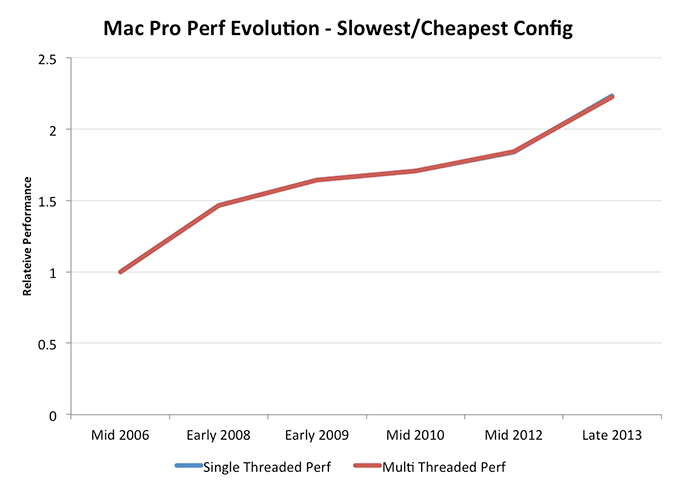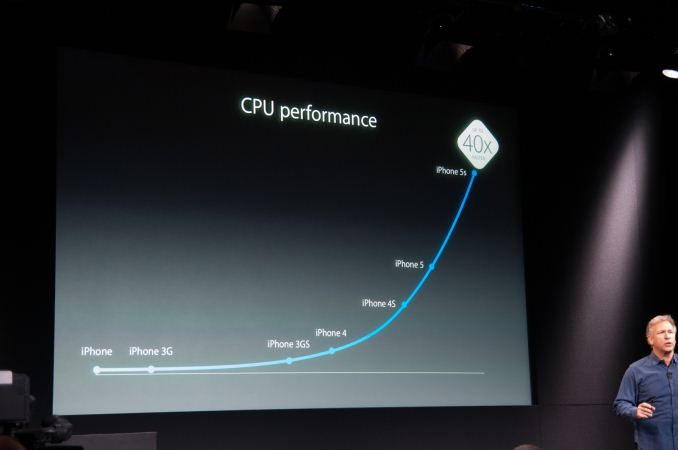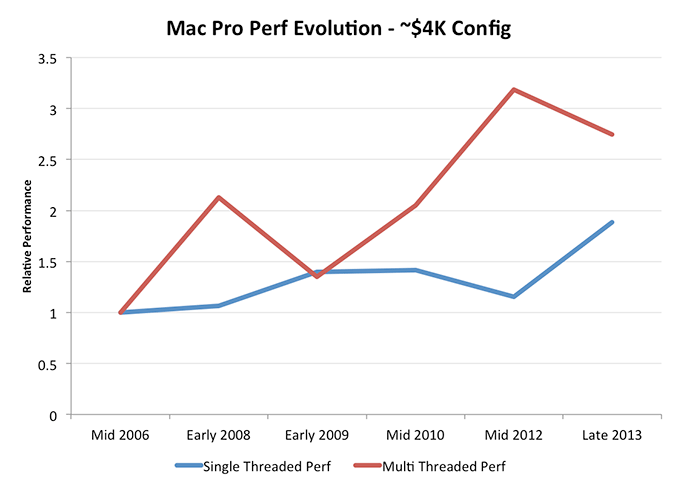The Mac Pro Review (Late 2013)
by Anand Lal Shimpi on December 31, 2013 3:18 PM ESTSetting Expectations: A Preview of What's to Come in Mobile
Sitting in the audience at the iPhone 5s launch I remember seeing this graph showing iPhone CPU performance increase since the first iPhone. Apple claimed a 41x increase in CPU performance if you compared the Cyclone cores in its A7 SoC to the ARM11 core in the first iPhone. What’s insane is just how short of a time period that comparison spans: 2007 - 2013.
I ran SunSpider on all of the iPhones in our 5s review to validate Apple’s numbers. I came out with roughly a 100x increase in performance, or something closer to half of that if you could run later versions of iOS (with Safari/js perf improvements). SunSpider is a very CPU and browser bound workload, but even if we turn to something a bit closer to real world usage like Browsermark 2.0 I measured a 5x increase in CPU performance over the past 6 years of iPhones.
I frequently refer to the progress we’ve seen in mobile as being hyper-moore’s-law. Until recently, the gains in mobile hadn’t yet approached a point where they were limited by process technology. Instead it’s variables like cost or time to market that govern how much performance was delivered each year. We’re at the beginnings of all of this changing, and it’ll eventually look a lot like what we’ve had in the desktop and mobile CPU space for years now.
When performance results from the new Mac Pro first hit, there seemed to be disappointment in how small some of the gains were. If you compare it to the progress in CPU performance Apple has demonstrated on the other side of the fence, you’re bound to be underwhelmed.
Having personally reviewed every CPU architecture that has gone into the Mac Pro since its launch, I had a rough idea of what to expect from each generation - so I decided to put it all in a chart.
I went back through all of my Conroe, Penryn, Nehalem, Westmere and Ivy Bridge data, looked at IPC improvement in video encoding/3D rendering workloads and used it to come up with the charts below. I made a table of every CPU offered in the Mac Pro, and scaled expected performance according to max single and multicore turbo.
Let’s first start by looking at what you can expect if you always buy the absolute cheapest Mac Pro. That means starting off with the Xeon 5130, moving to the E5462, then the W3520, W3530, W3565 and ending up with the E5-1620 v2 in today’s Mac Pro. I’ve put all of the choices in the table below:
| Mac Pro - Cheapest Configuration Upgrade Path | ||||||||||
| CPU | Chips | Cores per Chip | Total Cores / Threads | Clock Base/1CT/MaxCT | Launch Price | |||||
| Mid 2006 | Xeon 5130 | 2 | 2 | 4 / 4 | 2.0/2.0/2.0 GHz | $2199 | ||||
| Early 2008 | Xeon E5462 | 1 | 4 | 4 / 4 | 2.8/2.8/2.8 GHz | $2299 | ||||
| Early 2009 | Xeon W3520 | 1 | 4 | 4 / 8 | 2.66/2.93/2.8 GHz | $2499 | ||||
| Mid 2010 | Xeon W3530 | 1 | 4 | 4 / 8 | 2.8/3.06/2.93 GHz | $2499 | ||||
| Mid 2012 | Xeon W3565 | 1 | 4 | 4 / 8 | 3.2/3.46/3.33 GHz | $2499 | ||||
| Late 2013 | Xeon E5-1620 v2 | 1 | 4 | 4 / 8 | 3.7/3.9/3.7GHz | $2999 | ||||
If you always bought the cheapest Mac Pro CPU offering, this is what your performance curve in both single and multithreaded workloads would look like:

The first thing that stands out is both workloads follow roughly the same curve. The entry-level Mac Pro has always been a quad-core option, so you get no increased MT scaling (if you exclude the initial Nehalem bump from enabling Hyper Threading, which all subsequent Mac Pros have supported).
If you’ve always bought the slowest Mac Pro you’ll end up with a Mac Pro today that’s roughly 2.2x the performance of the very first Mac Pro. It’s a substantial increase in performance, but definitely not the sort of gains we’ve seen in mobile. For anyone who has been following the x86 CPU evolution over the past decade, this shouldn’t come as a surprise. There are huge power tradeoffs associated with aggressively scaling single threaded performance. Instead what you see at the core level is a handful of conservatively selected improvements. Intel requires that any new microarchitectural feature introduced has to increase performance by 2% for every 1% increase in power consumption. The result is the end of unabated increase in single threaded performance. The gains you see in the curve above are more or less as good as they get. I should point out that this obviously ignores the ~10% IPC gains offered by Haswell (since we don’t yet have a Haswell-EP). It’s also worth noting that Intel presently delivers the best single threaded performance in the industry. Compared to AMD alone you’re looking at somewhere around a 40% advantage, and ARM doesn’t yet offer anything that competes at these performance levels. It’s bound to be harder to deliver big gains when you’re at this performance level.
Back to the curve at hand, the increase in performance the 2013 Mac Pro offers is arguably one of the best upgrades over the life of the system - assuming you always opted for the entry level quad-core configuration.
What if you always did the opposite though and picked the highest-end CPU configuration? Same deal as before, I’ve documented the upgrade path in the table below:
| Mac Pro - Most Expensive Configuration Upgrade Path | ||||||||||
| CPU | Chips | Cores per Chip | Total Cores / Threads | Clock Base/1CT/MaxCT | Launch Price | |||||
| Mid 2006 | Xeon X5365 | 2 | 4 | 8 / 8 | 3.0/3.0/3.0 GHz | $3999 | ||||
| Early 2008 | Xeon X5482 | 2 | 4 | 8 / 8 | 3.2/3.2/3.2 GHz | $4399 | ||||
| Early 2009 | Xeon X5570 | 2 | 4 | 8 / 16 | 2.93/3.33/3.06 GHz | $5899 | ||||
| Mid 2010 | Xeon X5670 | 2 | 6 | 12 / 24 | 2.93/3.33/3.06 GHz | $6199 | ||||
| Mid 2012 | Xeon X5675 | 2 | 6 | 12 / 24 | 3.06/3.46/3.2 GHz | $6199 | ||||
| Late 2013 | Xeon E5-2697 v2 | 1 | 12 | 12 / 24 | 2.7/3.5/3.0 GHz | $6999 | ||||
Now things start to get interesting. For starters, single and multithreaded performance scaling is divergent. The high-end CPU option started as two quad-core CPUs but after three generations moved to a total of twelve cores. What this means is that after the early 2009 model you see a pretty significant increase in multithreaded performance for the fastest Mac Pro configuration. Scaling since then has been comparatively moderate as you’re looking at IPC and frequency improvements mostly with no change in core count.
The single threaded performance improvement, by comparison, is fairly mild. If you bought the most expensive Mac Pro configuration back in 2006 you had a 3GHz part. In the past 7 years peak single core turbo has only improved by 30% to 3.9GHz. Granted there are other efficiency gains that help push the overall improvement north of 50%, but that’s assuming you haven’t purchased anything since 2006. If you bought into the Mac Pro somewhere in the middle and opted for a high-end configuration, you definitely won’t see an earth shattering increase in single threaded CPU performance. Note that we’re only looking at one vector of overall performance here. We aren’t taking into account things like storage and GPU performance improvements (yet).
For the third configuration I wanted to pick something in the middle. The issue is that there is no middle config for entirety of the Mac Pro’s history. In some cases shooting for the middle meant you’d end up with 4 cores, while other times it meant 6, 8 or 12. We settled on trying to shoot for a $4000 configuration each time and never go above it. It turns out that if you always had a $4000 budget for a Mac Pro and tried to optimize for CPU performance you’d end up with a somewhat bizarre upgrade path. The path we took is listed in the table below:
| Mac Pro - Mid-Range Configuration Upgrade Path | ||||||||||
| CPU | Chips | Cores per Chip | Total Cores / Threads | Clock Base/1CT/MaxCT | Launch Price | |||||
| Mid 2006 | Xeon 5160 | 2 | 2 | 4 / 4 | 3.0/3.0/3.0 GHz | $3299 | ||||
| Early 2008 | Xeon E5472 | 2 | 4 | 8 / 8 | 3.0/3.0/3.0 GHz | $3599 | ||||
| Early 2009 | Xeon W3580 | 1 | 4 | 4 / 8 | 3.33/3.6/3.46 GHz | $3699 | ||||
| Mid 2010 | Xeon W3680 | 1 | 6 | 6 / 12 | 3.33/3.6/3.46 GHz | $3699 | ||||
| Mid 2012 | Xeon E5645 | 2 | 6 | 12 / 24 | 2.4/2.67/2.4 GHz | $3799 | ||||
| Late 2013 | Xeon E5-1650 v2 | 1 | 6 | 6 / 12 | 3.5/3.9/3.6 GHz | $3999 | ||||
Around $4000 the Mac Pro went from a quad-core system to eight-cores, back down to four cores, then up to six, then twelve and finally settling back at six cores this generation. What this means is a cycling between improving single and multithreaded performance over the course of the past 7 years:
Here’s where the comparison gets really interesting. If you spent $3799 on a Mac Pro last year, in order to see a multithreaded performance uplift on the CPU side you’d need to spend more this year. Single threaded performance on the other hand sees a big uptick compared to last year. The 2012 $4K config is the outlier however, if you have a budget fixed at $4000 then a 2013 Mac Pro will be quicker in all aspects compared to any previous generation Mac Pro at the same price point.
The bigger takeaway from this is the following: the very same limited gains in CPU performance will eventually come to ultra mobile devices as well. It’s only a matter of time before those CPU curves flatten out. What that does to the smartphone/tablet market is a discussion for another day.













267 Comments
View All Comments
wallysb01 - Friday, January 3, 2014 - link
Actually, you can upgrade the CPU. What you can’t do is replace the monitor.Liquidmark - Friday, January 3, 2014 - link
You can attach external monitors to the iMac.Liquidmark - Friday, January 3, 2014 - link
"The problem with saying Apple's pricing isn't out of touch with reality is that you can't only compare this to high end workstation's from other companies..."This is a workstation. It has workstation components and is formally classified as such, so you kinda have to compare it to *gasp* OTHER workstations and match their spec as closely as possible to see if the price of the Mac Pro is reasonable or not. Anand is absolutely correct in comparing this to a HP Z420 which is HP's mid-range workstation right now.
"this is Apple's only desktop-ish device."
Ever heard of the Mac Mini?
"Apple doesn't provide options for people who want a high end notebook or desktop for normal use.."
Ever heard of the Macbook Pro or iMac?
You can't discount the fact that the Mac Pro has Xeons under the hood just because you don't like the other options Apple offers. If the Mac Pro has Xeons under the hood, then you have to factor that into the price of the device. You don't get to ignore the engine in a Bently to claim that a Bently is thus overpriced when compared to a Toyota Corolla. You don't get to say that it should have an engine from a Toyota Corolla and that theuy shouldn't have the luxury features and hand-crafted attention to detail that come with a bently. If you want a Toyota corolla, go buy a Toyota Corolla. If you want a Dodge viper, go buy that. Don't tell Bently to make a Toyota Corolla or a Dodge viper and don't expect to buy a bently at the cost of a toyota corolla or dodge viper either because you seem to dismiss the facts that there are differences between the three.
"it's at least 2x as expensive as it should be for it's base unit"
Not according to actual price comparisons it isn't..
Bobs_Your_Uncle - Thursday, January 2, 2014 - link
I'm still wondering how that Nokia Lumia 1020 review is coming along !?p51mustang6 - Thursday, January 2, 2014 - link
You should really do research, just a little, prior to making a review like this, you make a bold statement saying how the Mac Pro is so great and for so cheap, yet you compared it to two companies far from known for making anything professional. Try comparing the Mac Pro to The Origin Genesis Pro-X2 from Origin PC. It starts out with considerably higher specs with a LOWER price tag. They also offer up to dual Intel Xeon E5-2697 Dodeca-core processors (that's 12 cores each CPU for those of you who couldn't handle that) for a total of 24 cores (or twice that of the Mac Pro), up to dual 12GB NVIDIA Quadro K6000s (Apple doesn't even offer anything even closely comparable lol), up to 256GB of RAM (Apple offers up to 64GB), up to 4TB of SSD storage (compared to Apple's 1TB, granted PCI), comes standard with liquid cooling (Apple does not offer), up to an additional 12GB NVIDIA Tesla K40 (once again Apple offers nothing of the sort), Origin comes with one year warranty upgradable to 3 years but also comes standard with LIFETIME support with 24/7 United States based support (I wonder where Apple's support that you get 90 days of is based...lol) The starting price of the Origin is $3,712 compared to $3,999 of the Mac Pro which does not come with dual processors. The trash can is a complete rip off which requires you to go out and use their thunderbolt ports in order to do any real upgrading so you will have random things sitting on your desk, the Origin perhaps bigger, but at least all the goods will always be inside of it. Instead of spending all their time trying to make a computer a cylinder maybe Apple should have tried to compete with the real heavy hitters such as Origin PC.Louiek - Thursday, January 2, 2014 - link
Hi, I am currently myself trying to compare a maxed out mac pro ~ $10k CAD with other OEM workstations of similar spec. I looked into origin but I can't seem to build a similar spec'd (i.e. single Xeon E5-2697v2 etc) that will cost under $11k CAD. Is there something I am missing as your comment leads me to believe that I can build a cheaper PC with origins with similar specs.Liquidmark - Friday, January 3, 2014 - link
You can't the Origin machine only offers extreeeeme options that are ideal for gaming with neon lights. Its solution to things is to throw more cores at it and throw more ram at it even though the ram is slower...stingerman - Thursday, January 2, 2014 - link
Sorry dude, triedto configure a comparable system and it costs more than the Mac Pro...Liquidmark - Friday, January 3, 2014 - link
Ok, I'll bite...Mac Pro:
2.7GHz 12-core with 30MB of L3 cache
32GB (4x8GB) of 1866MHz DDR3 ECC
256GB PCIe-based flash storage
Dual AMD FirePro D700 GPUs with 6GB of GDDR5 VRAM each
User's Guide (English)
$8000 and weighs roughly 11 pounds
GENESIS Pro-X2
ASUS Z9PE-D8 WS
Dual ORIGIN FROSTBYTE 120 Sealed Liquid Cooling Systems
Dual Intel XEON E5-2630 v2 Hex-Core 2.6GHz (3.1GHz Turbo) 15MB Cache (That's 12 cores at a lower clock than the Mac Pro build)
1000 Watt Corsair RM1000
Dual 6GB NVIDIA Quadro 6000 (Non-SLI)
32GB Kingston ECC 1600MHz (4x8GB)
Genuine MS Windows 7 Professional 64-Bit Edition
250GB Samsung 840 Evo Series
ASUS 24X CD/DVD Burner
On Board Audio
Onboard Network Port
ORIGIN Wooden Crate Armor
1 Year Part Replacement and 45 Day Free Shipping Warranty with Lifetime Labor/24-7 Support
ORIGIN Recovery USB3.0 Flash Drive
ORIGIN PC G8 T-Shirt XL
Microsoft Internet Explorer
$11,017 and weighs over 70 pounds.
Now, before anyone says anything, the tee shirt was free and the water cooling was the only offer plus they give a free games offer that I didn't take. Tho I probably should since apparently workstations are all about pro gaming, neon lights and being extreeeeeme.
Liquidmark - Friday, January 3, 2014 - link
Also, if anyone wants to argue that you can get dual 12-core on the origin machine, I'll simply point out that, at spec, I'd almost be able to buy two 12 core Mac Pros. Just saying.